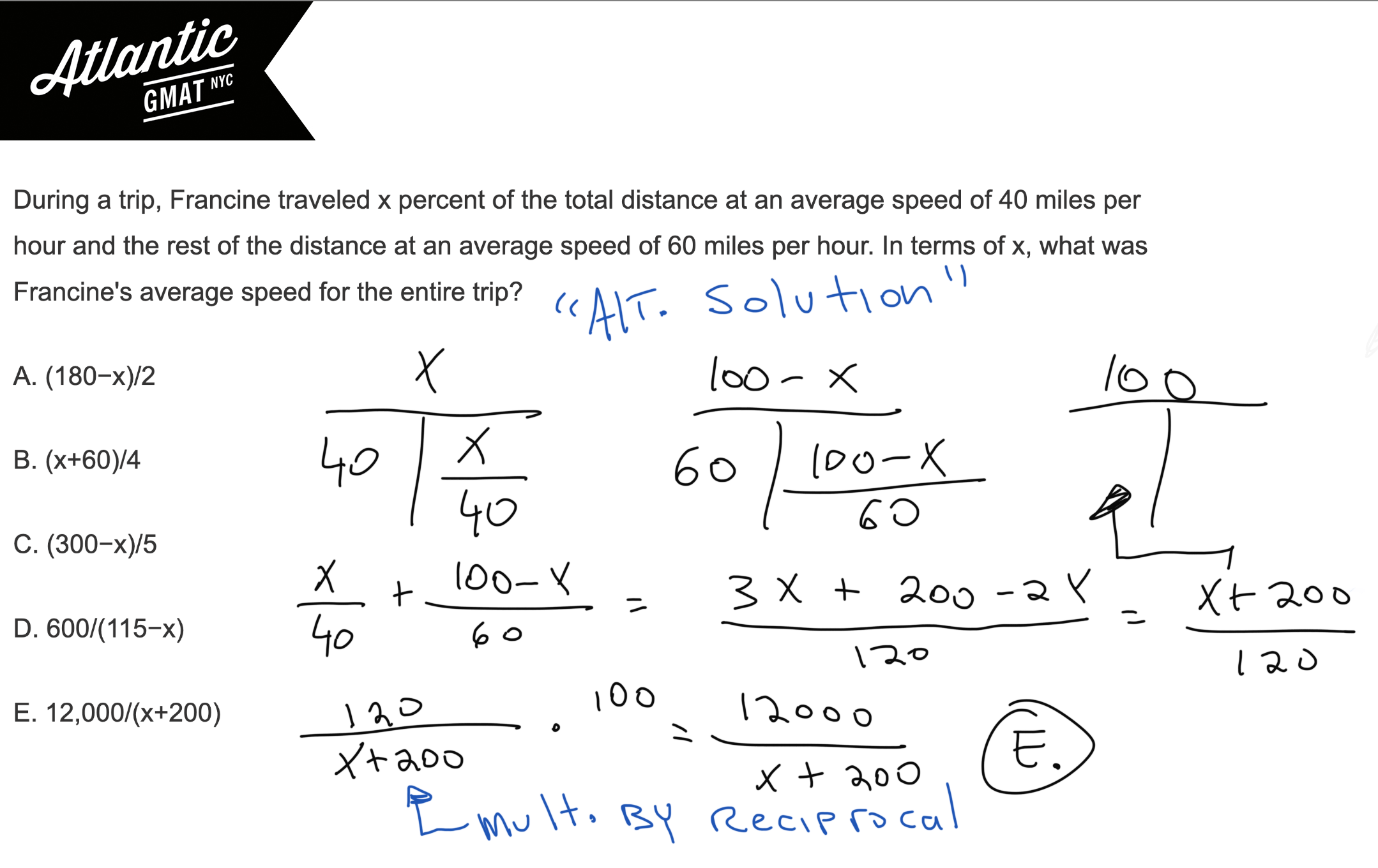During a trip, Francine traveled x percent of the total distance at an average speed of 40 miles per hour and the rest of the distance at an average speed of 60 miles per hour. In terms of x, what was Francine’s average speed for the entire trip? GMAT Explanation, Video Solution, and More Practice!
During a trip, Francine traveled x percent of the total distance at an average speed of 40 miles per hour and the rest of the distance at an average speed of 60 miles per hour. In terms of x, what was Francine’s average speed for the entire trip?
A. (180−x)/2
B. (x+60)/4
C. (300−x)/5
D. 600/(115−x)
E. 12,000/(x+200)
Average speed, distance, miles per hour… Yes, it’s a GMAT work and rate question. In this case we have an average rate with variables in the question and in the answer choices. That’s a signal for considering picking numbers. Why pick numbers? To make life easier. How do I judge if picking numbers will make life easier? If the question would be a simple 1-2-3 if you had the actual numbers that’s a pretty good indicator. Here, if you just had to calculate the average speed, assuming you know how to do a weighted average, things would be smooth. Here’s another GMAT word problem from the GMAT Official Guide on which you can pick numbers to make things much easier.
Let’s get back to Francine and her trip! Let’s define the question: what was Francine’s average speed for the entire trip?
Now let’s take inventory. What numbers are we missing? Distance! Yes, I’d go ahead and pick a distance for the trip. Pick something that works well with the speeds, 40 and 60. Why not go for 240 total distance and divide that into 120 and 120 for each leg of the trip? That way you’ve got easy division.
120 miles/40mph = 3 hours
120 miles/60mph = 2 hours
Total time = 5 hours
Total distance = 240 miles
240/5 = 48mph
Just as a sanity check for the 48. We spent more time (3 hours) traveling at the slower speed (40mph) so it makes sense that the average speed would be closer to 40mph than 60mph.
OK, so, with total distance at 240 the average speed is 48. Of course, that’s not an answer. We have to plug in “x”, the total distance at an average speed of 40 miles per hour, in order to yield 48. We can use our divisibility shortcut here. Since we know the correct answer is 48 we know that the numerator has to be a multiple of 3 (because 48 is a multiple of 3). So just focus on the numerator and eliminate answer choices not divisible by 3.
A. (180−x)/2. 180-50 = 130
B. (x+60)/4. 50 + 60 = 110
C. (300−x)/5. 300-50 = 250
D. 600/(115−x) Div by 3
E. 12,000/(x+200) Div by 3
You end up with D and E as possibilities. At this point you can just work out the entire expression for both choices. You could also:
- Continue using divisibility. 48 has four 2’s in it. 600 only has 3. So that’s out.
- Use Magnitude. It should be pretty clear that D. is way too small.
So, in terms of x, what was Francine’s average speed for the entire trip? E. 12,000/(x+200)
I think picking numbers is a great way to go on this one. You can also do the algebra which could be a little faster depending on how speedy you are at setting it up but, at least in my mind, is less straight forward and I’ve seen many GMAT tutoring students screw it up. I’ll do the algebra in the diagram and in the video for your reference.
Video Solution: During a trip, Francine traveled x percent of the total distance at an average speed of 40 miles per hour and the rest of the distance at an average speed of 60 miles per hour. In terms of x, what was Francine’s average speed for the entire trip?
Additional GMAT Work and Rate/Weighted Average Practice
Here’s a work and rate question from GMAT Question of the day which has the same basic structure and explains the rate t’s a bit more.
And another average rate question from the GMAT Question of the day
Here’s a very challenging average rate question from the GMAT Prep Tests. Same basic premise but on this one the follow through is tougher because it involves a quadratic.
GMAT Work and Rate question from the Official Guide to practice picking numbers. It’s a cooperative rate so the follow through is a bit different than the above “Francine” average rate but you can still use rate T’s and again pick numbers: Working simultaneously at their respective constant rates, Machines A and B produce 800 nails in x hours



